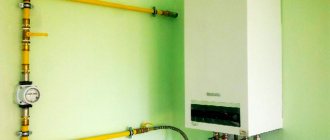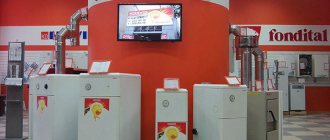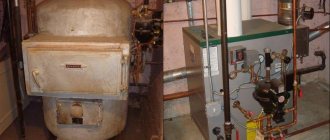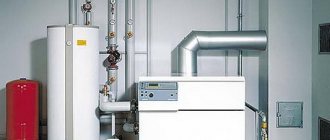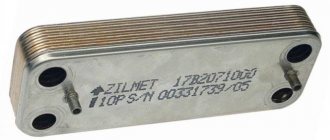In private houses where main gas supply is provided and possible, the owners often decide the principle of gas equipment that will be located in the house. After all, a gas boiler is capable of not only heating the coolant circulating through the internal circuit and providing heating for the radiators, but also preparing hot water in the boiler for household needs. For this purpose, it is quite possible to consider purchasing a single-circuit gas boiler with an indirect heating boiler.
Principle of operation
Gas single-circuit boilers with an indirect boiler operate according to two main connection schemes. The principle of operation of the first is as follows:
- The three-way valve dominates here. A pump is installed directly into the outlet of the gas boiler, which provides circulation and creates pressure. The next step is to install a three-way valve, which is connected to the boiler thermostat. When heating tap water or other coolant, its flow is directed to the heating system, with priority for the hot fluid entering the boiler coil. This happens with the help of an additional, second pump. And it turns out that in this case the hot water supply and the heating system are connected in parallel, and they can form two circuits, precisely in this closed chain. And after the boiler, an additional pump is installed, which helps regulate the operation of the thermostat. The principle of starting and stopping the process is also regulated by a thermostat, namely, when the heating is strong, the fuel supply is forced to shut off, when the coolant cools down, the fuel is passed through again, and the burner is automatically ignited.
- If there is no double circuit and priority is not given to heating hot water, the boiler is mounted in a common system, installed in a convenient location, and water is heated along with all radiators.
You might be interested >> The operating principle of a Bosch double-circuit boiler
DIY assembly and connection instructions
The boiler is assembled after preparing all the components.
Holes are drilled in the tank: for the water filling tap, coolant inlet and outlet. If you decide to install a heating element, then a hole is also made for it at the bottom.
- Next, a coil is installed in the container, and the tubes are passed into the holes using special adapters, which it is advisable to weld into the boiler body. Other options are possible, but the main thing is that the holes are sealed hermetically.
- The legs are welded to the bottom (if provided).
- A heating element is installed if this was planned.
- Then the coil is connected to the heating system circuit, according to the diagram.
- A pipe for cold water supply and a tap for heated water are connected. You can immediately make connections to water collection points - to the kitchen and bathroom.
Thermal insulation
In order for the water to retain heat for a long time, the container is thermally insulated. For it, foiled mineral wool or polyurethane foam is used. The boiler body must be completely covered in thermal insulation material - the performance efficiency of the device will directly depend on this. To make the insulation look neat, you can place a casing made of thin sheet metal (for example, galvanized) on top of it - you get something similar to a sandwich pipe. A visual example is in the first picture of the article.
The principle of operation of a wood boiler
Another type of indirect heating water heater is wood-burning titanium, which will only require the cost of creating a supply of solid fuel. This boiler has a samovar design and operates autonomously from all power sources, so it is ideal for installation in a private home.
The principle of operation of a titanium boiler
To build such a device with your own hands, you must first build a stove, which will heat the water inside the tank. Such a boiler can have a round or square tank, and it can be installed either on a small stove made of brick or on a stove like a potbelly stove welded from a piece of metal pipe of a sufficiently large diameter.
- The second option is more complicated due to the fact that sections of metal will have to be cut out of the pipe to install firebox and vent doors in these places. In addition, using welding inside the pipe, you need to strengthen the brackets for laying the grate. The bottom and top of the oven stove are welded with solid sheets of metal. A round hole is made in the upper part, a chimney pipe is welded into it, which will pass directly through the container with water and heat it to the desired temperature.
The tank must also be welded to the furnace lid.
- If you decide to make the stove out of brick, the boiler tank can be either round or square. The top of the stove is covered with a metal panel, into which a chimney pipe is also welded. Next, a container without a bottom (water tank) is hermetically welded to the upper metal plane of the furnace.
The chimney, after passing through the water tank, is discharged to the street.
Two or three pipes with valves must be welded into the tank: for water inlet, for outlet to the mixer tap and to the shower.
Specifications
When choosing a model of the system in question, the technical characteristics must correspond to the level of expected comfort and the amount of heat and hot water used. Since they will vary greatly depending on the area of the room and the activity of using the system. Because some owners visit private houses only for a short period of time, while others live in them permanently.
The number of people living and the presence of pets also greatly influences. Because, in any case, the more people live, the more hot water is used. Therefore, when choosing a model, it is necessary to take into account all the characteristics of the heated object in order to choose the best option.
Which boiler to choose?
For the construction of warm water floors, the model of a flow-through electric boiler is practically not suitable. The main disadvantage is the significant energy consumption.
The only suitable option for heated floors is a storage water heater. When choosing the type of heater, attention should be paid to the power of the equipment; this determines how intensively and quickly the coolant is heated, as well as its volume.
For your information! Devices with a power of 6 - 10 kW are specially designed for installation in conjunction with heating systems. Their main disadvantage is their high electricity consumption.
When calculating the power of an electrical appliance, you should start from the fact that to heat an area of 10 square meters you need a water heater with a power of 1 kW, so a household boiler model is not suitable for heated floors. It can only be used for small rooms - a bath or toilet.
The second point that you need to pay attention to when purchasing is the volume of the tank. The greater the amount of hot coolant received, the less often the water heater will be turned on periodically, in order to help save resources.
Installation features
Installation features include the following:
- the entire piping of the water heater itself must be connected not only to the heating system, but also to both water supply lines, that is, to both cold and hot water;
- It should be noted that the cold water input is connected to the system from below, and the hot water is discharged from the top of the tank, while the recirculation point is located approximately in the middle of the boiler tank;
- the heated coolant must move along the circuit from top to bottom;
- It is worth noting that the coolant liquid moves to the upper nozzle, and then returns back into the bosom of the heating line from the lower nozzle of the container. It is this feature that helps increase efficiency, since heat is initially transferred to the warmest layers of the coolant;
- it is important to know in what ways you can connect the boiler so that it works correctly, making the most of its resources;
- It is for a single-circuit gas boiler with an indirect heating boiler that a sensor is provided that regulates the temperature, and it is installed directly in the tank;
- When connecting a boiler to a single-circuit boiler, it is necessary to use a circuit with two circulation pumps. It is important to note that this type can replace the previously discussed three-way sensor circuit;
- it is important to know that the connection features also include the separation of flows through which the coolant moves;
- due to the way the heating system assembly algorithm is configured, either the water heating system or the circuit where the coolant circulates can take precedence in receiving heat;
- The thermostat also regulates the alternating activation of both pumps installed in the tank.
Warm floors from an electric boiler - the main nuances of such a system
Heating private spaces using heated floors is becoming quite popular among home owners. One of the types is the organization of a system based on water pipes. In this case, the issue of proper selection of a source of warm water becomes urgent. And one of the types is the use of an electric water heater.
Water heating system
Application of a water heater
When installing a heated hydraulic floor, the homeowner needs to solve two problems:
- get a working structure that heats the air in the room to the optimal temperature,
- choose a cost-effective option at the manufacturing stage and during the work.
For heated floors, electric or gas water heaters are used, which provide local heating in the apartment. However, in the case when the apartment is connected to the main heating system, this will not work. It is not allowed to connect other consumers to the system, except for installed radiators.
In this situation, it is necessary to look for alternative sources, and one of which is electric
electric storage water heater. Of course, this device is not designed for such an application, and the TP circuit will become an additional load on it. And this can lead to failure of the drive. And yet the creation of such a structure is permitted.
The main thing here is to correctly calculate the loads - heating large areas with an electric water heater will not work. But for TP installed in the bathroom or kitchen, this source is enough.
Types of electric water heaters
The abundance of water heater models on the market is divided into two groups:
The first ones are connected to the cold pipeline circuit and provide virtually instant heating of the water when turned on. But at the same time, high loads are applied to the electrical network, because the power of these devices is 6-10 kilowatts. Thanks to this, for underfloor heating
These heaters are not suitable.
Main! Flow type heaters are powerful consumers of electrical energy.
Flow type heater
Unlike flow-through heaters, storage type heaters are a large container with a tubular heater. The power of such devices is 1.5-2 kilowatts, and the volume is 50-100 liters. In terms of design, they can resemble a thermos - the water in them quickly heats up and slowly cools down. In addition, storage devices are equipped with a thermostat, thanks to which the water is heated to the temperature specified by the client.
There are also boilers of significant volume on the market - 250-300 liters. But they are rarely used for home needs. By the way, these devices can be designed specifically for use in heating systems; they have different placement of the inlet and outlet holes for water.
When designing a heated floor, it is important to take into account the power consumption required for an electric storage water heater to heat the room. Naturally, for the calculation we take 1 kW per 10 square meters of room
It turns out that an average boiler will be able to heat 15-20 square meters of space.
Heat loss must also be taken into account. They average 100 W per 10 squares. Moreover, this figure depends on certain factors:
- type of room,
- quality of floor insulation,
- room floor,
- heating circuit
design technique .
Due to this, when calculating the system, it is better to make a small reserve - this way, a situation will not arise when the boiler power is insufficient.
Invisible moments of connection
In order for the structure to work fully, the following invisible points must be taken into account during design and connection:
- placement of an electric water heater - it is better that it is located fairly close to the heated room,
- difficulty of the heating circuit - the longer and more complex the pipe circuit, the very slowly water flows through it, therefore, heat losses increase,
- the power of an electric water heater should be 15-20% higher than the calculated energy consumption,
- In order to improve the operating efficiency of heated floors, it is recommended to connect a circular pump to the system.
At the same time, it will be necessary to provide for a very high load on the boiler. Because of this, he needs regular preventative care.
Making a heated floor from a heating electric water heater is not very difficult. It will be able to provide sufficient heating of the room, and the installation process of the system is the simplest
However, it is necessary to take into account the low power of such a device and count on heating small areas
Requirements for the location of such a boiler
Single-circuit gas boilers are divided into floor-mounted and wall-mounted, and, depending on the model purchased, there will be special requirements for the room:
- For wall-mounted single-circuit gas installations it is necessary: the presence of at least one window in the room where the boiler itself will be located;
- you need to install a chimney;
- The boiler is best located close to the boiler.
- equipment of a separate room;
You might be interested >> Danko gas floor-mounted single-circuit boilers
Power calculation and equipment selection
Initially, in order to select a BKNSR scheme and select equipment, it is necessary to calculate the thermal load on the domestic hot water supply for a specific consumer. An incorrectly selected connection method will lead to ineffectiveness of the DHW recirculation system or breakdown of the main and pumping equipment.
How to choose a boiler
For example, to perform the calculation, for a family of 4 people they take hot water standards according to SNiP 2.04.01-85 “Internal water supply and sewerage of buildings.”
Simple calculations show that washing dishes will require 336 l/week, showering - 1280 l/week, and minor activities another 280 l/week, for a total of 2856 l/week or 17 l/hour.
Formula for determining power:
17x0.0375=0.637kW
Heater design parameters:
- The minimum volume of water consumption is 1.5 l/min.
- Capacity volume - more than 100 liters.
- Water heating time is up to 2 hours.
- Thermal insulation material is polyurethane foam or mineral wool.
- Safety elements: valves, temperature and pressure sensors and fuses.
- Service life is from 10 to 12 years.
Reviews
Users who have already purchased the necessary equipment suggest that when choosing a single-circuit gas boiler with an indirect heating boiler, the consumer should pay attention to the following details:
- from which manufacturer is this design purchased, because if the plant producing the units is not yet widely represented, then in the event of the need for warranty repairs or other breakdowns, it will be extremely difficult to find a service station or the necessary parts;
- and wall-mounted gas installations are also very popular, because there is no need to build a separate room for them, as would happen if you purchased a floor-standing gas boiler;
- wall-mounted single-circuit gas boilers are quite easy to install in small rooms, and even in offices where there is no heating, because the body width is only 40-45 cm;
- According to reviews, it is necessary to purchase models that come complete with all the fasteners, as well as mounting elements that help you easily install the structure even yourself, without resorting to expensive outside help;
- It is worth paying attention to models where the water heating tank starts from 6-7 liters, and it is equipped with a circulation pump;
- convenient models with functions clearly displayed on the control panel, that is, you can freely adjust the temperature, control the thermostat, light the burner if necessary, and monitor the readings;
- the system must also provide data on its performance;
- It is advisable to purchase units that have a self-diagnosis function.
That is, before choosing a particular model, you should study in detail the reviews of consumers who are already using a specific design that has the functions necessary for the owner of the house.
Construction type
There are several main types of structures that are in demand:
- Tubular type coil. This variety is further divided into 2 subspecies. One coil is used in standard format boilers, two coils are used in indirect heating boilers connected to boilers or central heating.
- System of connected tanks. This system involves placing tanks inside each other; they are of different diameters, and are usually made of stainless steel. Water is poured into the internal tank, which will need to be heated. Coolant is poured into the external tank, through which heating will occur.
Electrical connection diagram
The combined version of the tank, equipped with a heating element, must be connected to the house electrical network, taking into account the transition to summer mode, in which the main coil will no longer receive heat from the boiler. We suggest using a universal circuit that includes a pump control module via a thermostat.
The colors of the wires shown in the figure correspond to the generally accepted classification: blue - neutral, brown - phase, yellow-green - ground, and so on
The circuit involves a second safety thermostat, which is activated when the sanitary water overheats. The indicator lamp signals that the heating element is turned on.
Calculation of tank capacity
In order to calculate the required volume of the boiler, it is necessary to determine how much hot water is consumed at a time or in a short period of time.
When taking readings, be guided by the morning time, when children are getting ready for school or kindergarten, and adults are going to work. After all, at this time everyone takes a shower, washes their face, brushes their teeth, which means that the most water is consumed at this time of day. If for some reason you do not have the opportunity to take readings, then you can use the table, which shows the hot water consumption indicators for various devices.
| Name of water consumer | Water consumption, l | Average temperature of consumed water, C° | Water consumption at 60 C°, l |
| Kitchen sink | 10-20 | 50 | 8-16 |
| Bath | 150-180 | 40 | 90-180 |
| Shower | 30-50 | 37 | 16-27 |
| Sink | 10-15 | 37 | 5-8 |
| Hand wash | 2-5 | 37 | 1-3 |
Having calculated these measurements, a reserve volume of 10-15% must be added to the resulting figure. This way you will get a boiler volume that will be optimal for your family.

